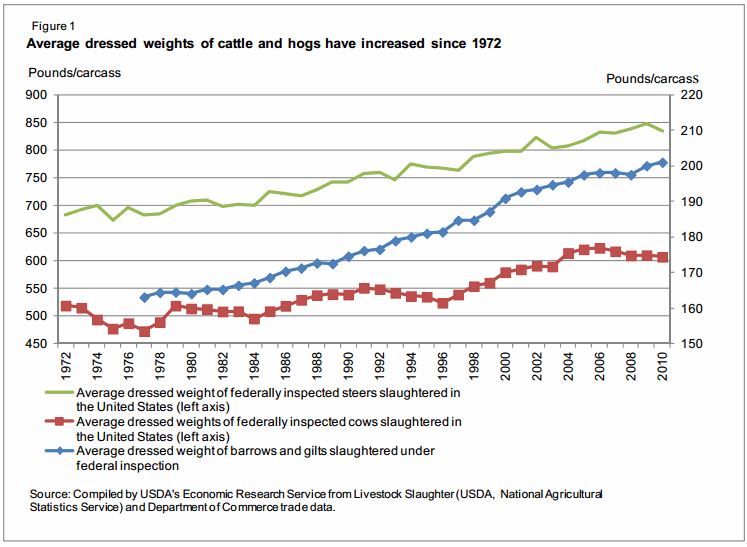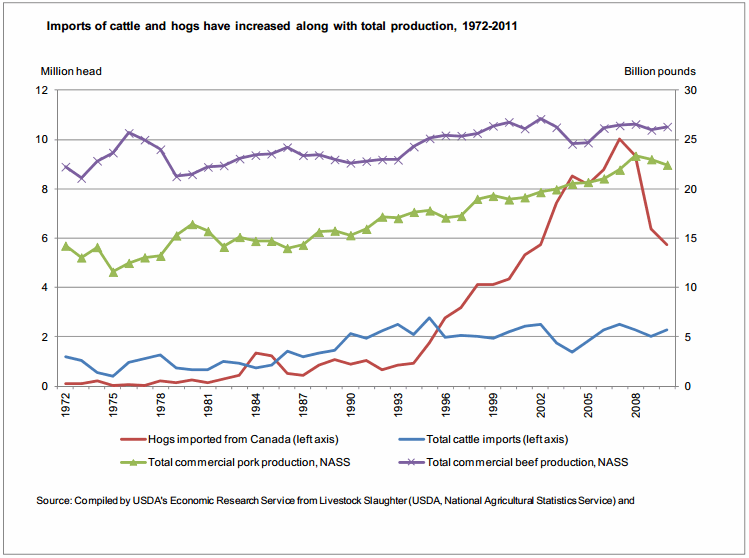Beef and pork production in the United States have increased since 1972. More beef is now produced with a smaller cow herd (basis: January 1 U.S. cow inventory) than at any other period in U.S. history. Dressed weights of steers (fig. 1), heifers, cows (fig. 1), and bulls have also increased. Similar increases have occurred in dressed weights of hogs (fig. 1). However, part of the increased production is from meat production from cattle and hogs imported into the United States for feeding and slaughter. Unless accounted for, this production from imported livestock clouds what can be said about changes in U.S. technical efficiency in beef production.
Greater detail in trade data since the early 1990s has made it possible to better assess the contribution of foreign livestock to U.S. beef production. As a result, data indicate that the quantity of meat produced from each head of breeding stock—in some sense, a measure of technical efficiency gains and genetic improvement—has increased since 1972. After adjusting for beef produced from foreign-born animals, Brester and Marsh (1999) estimated that beef production per U.S. beef cow increased by 26 percent over the 25-year period ending in 1998. In 1976, commercial beef production reached 25.667 billion pounds, which included an estimated 497 million pounds of beef produced from cattle imported from Canada and Mexico (Brester and Marsh, 1999). After subtracting beef produced from foreign cattle, an average of 457 pounds of beef was produced per U.S. cow in the U.S. base cow herd of 54.971 million cows (January 1, 1976 total cow inventory).
Extending the Brester-Marsh methodology beyond 1998—the end point in their original study—implies an increase in beef production per U.S. cow of 44 percent from 1972 to 2010. In the most recent peak year of 2008, 26.561 billion pounds of beef were produced, 1.565 billion pounds of that beef attributable to cattle imported from Canada and Mexico. Again adjusting for beef from foreign livestock, an average of 600 pounds was produced per U.S. cow in the January 1 total cow inventory of 41.692 million cows.
Federally inspected average dressed weights reported by USDA's National Agricultural Statistics Service (NASS) have increased steadily over time (fig. 1). Annual average dressed weights for all cattle in 1970 that averaged 624 pounds per head had increased by almost 26 percent to 784 pounds in 2009, the heaviest annual average weights to date. The dressed-weight measures in both years include effects from imported livestock.
The U.S. depends on foreign sources for a significant share of its red meat. These sources include both meat imported directly as beef, pork, or lamb and the meat produced in the U.S. from imported live animals. For beef, foreign sources have


accounted for as little as 8.2 percent (1974 and 1975) to as much as 18.2 percent (2005). Even during 2003 through 2005 when cattle imports from Canada were subject to restrictions due to the discovery of Bovine Spongiform Encephalopathy, beef from foreign sources accounted for 14.6 to 18.2 percent of U.S. beef supplies.
For 2011, cumulative imports of Canadian cattle into the United States were 35 percent lower year-over-year than in 2010, while imports of beef from Canada were 20 percent lower, again, year-over-year. Over the same period, imports of cattle from Mexico were up by over 16 percent. In 2011, estimated (by the Brester-Marsh method) beef produced from cattle imported into the United States from Canada and Mexico combined with all beef imported into the United States represented a quantity equal to about 11 percent of total U.S. beef supplies (excluding beginning cold storage stocks and on-farm production),. This was down from almost 13 percent in 2010 due to reduced imports of cattle from Canada.
Source: USDA.